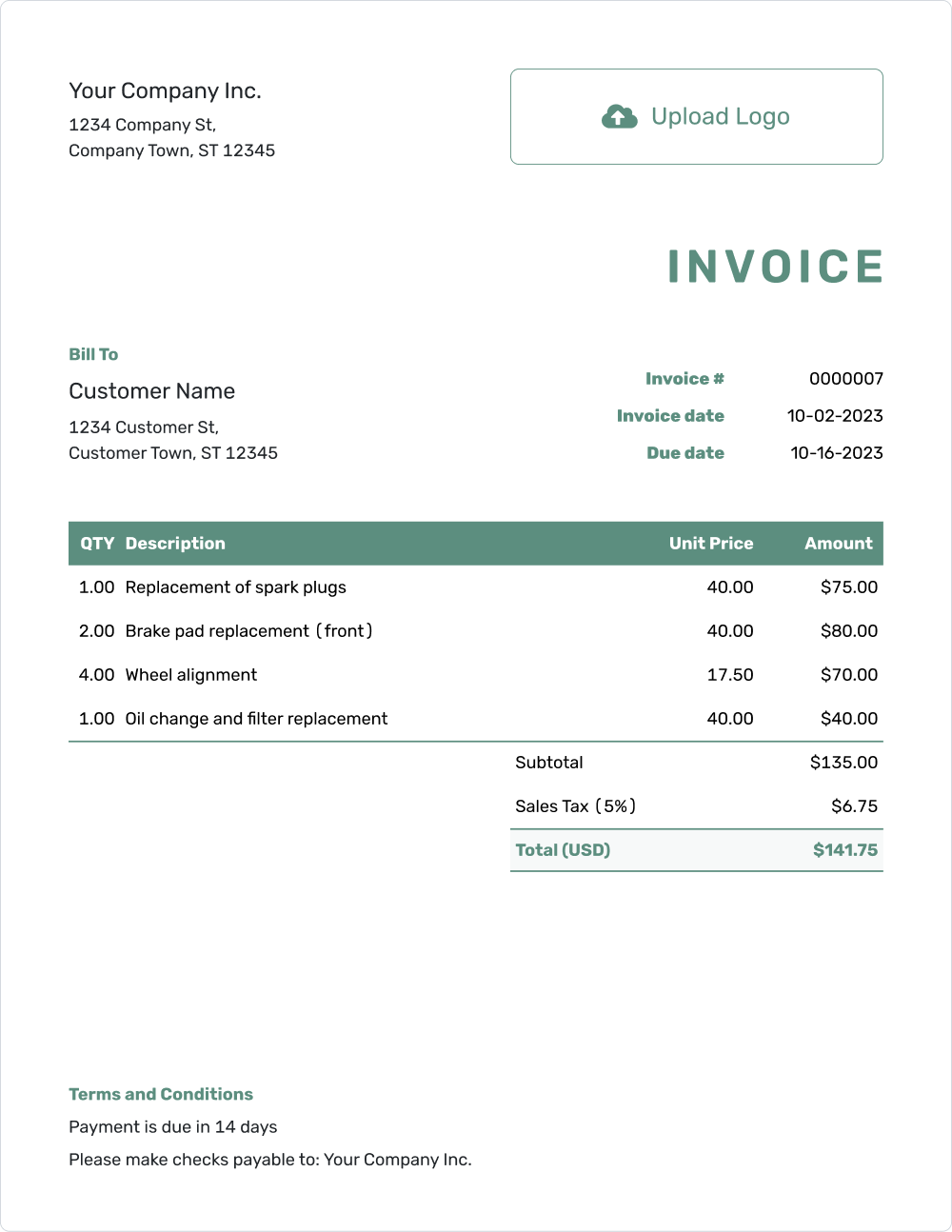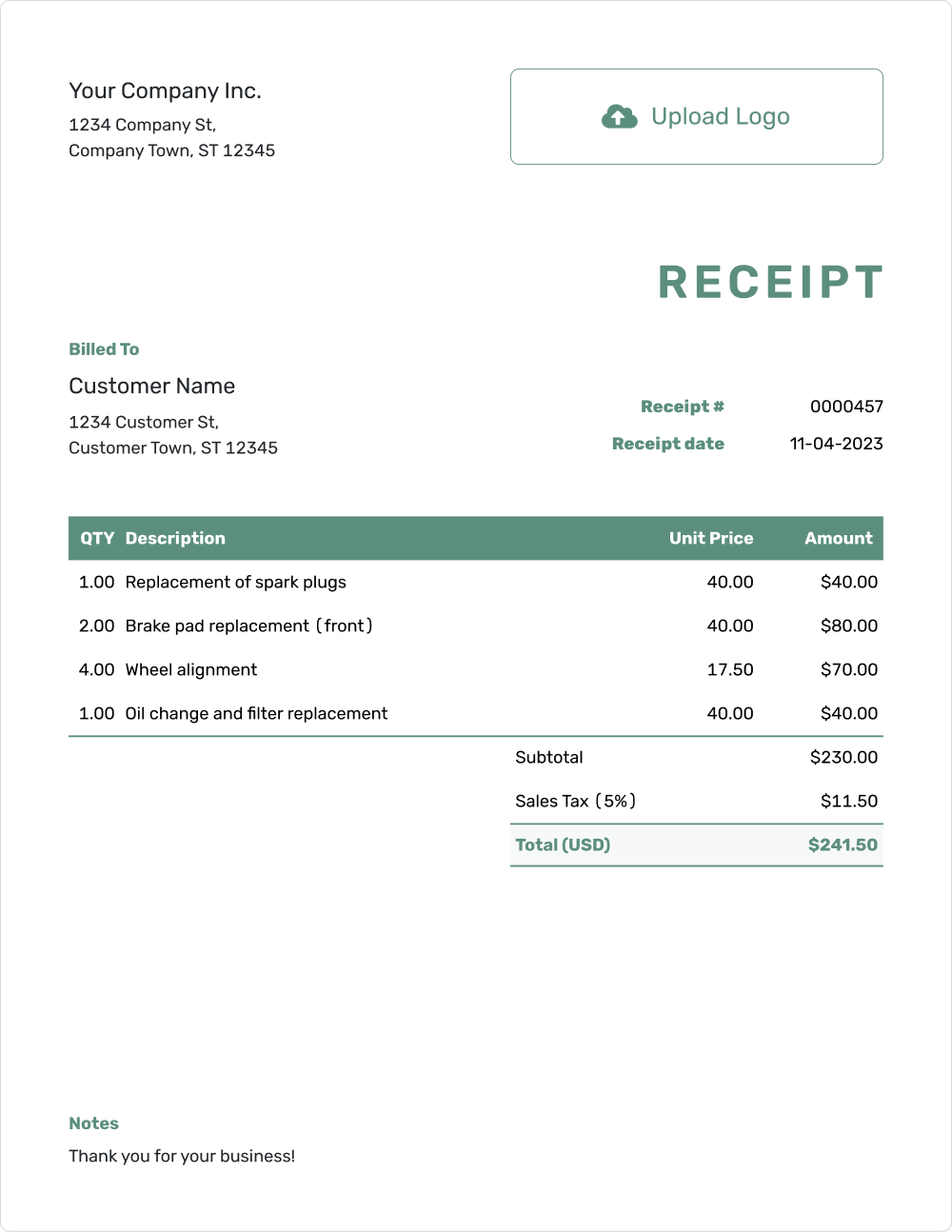Free Estimate Template
for business professionals
Create printable, itemized estimates in minutes with this free estimate template.
Print, download a PDF or email.
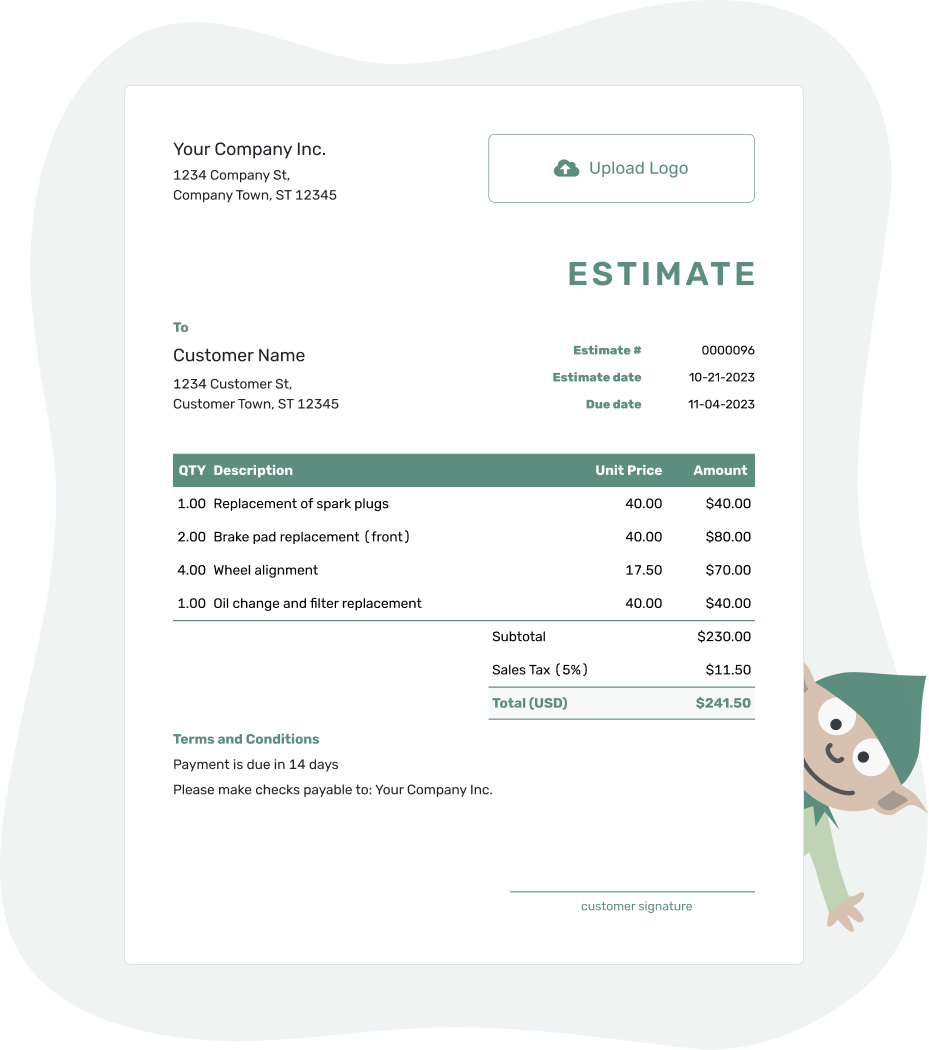
"Wow your customers - Grow your business"
Printable Estimate Template
This free printable estimate enables you to create both simple estimates and include more advanced items such as sales tax, P.O. number, discounts, or your company logo.
Docelf project estimates look clear and professional, and they make important information easy to understand. They are designed to leave a good impression on your customers, and set you apart from your competitors. Write your first estimate in no time using the free estimate generator.
How to do an Estimate
The free estimate template from Docelf is fillable, printable and downloadable. Just follow the 7 simple steps below to fill out the blank estimate template and write your first estimate proposal.
 1
2
3
4
5
6
7
1
2
3
4
5
6
7
1Your Company Information
Include your own information, such as your company name and your contact details. Make it easy for your customer to understand who the estimate is from and how to get in touch. Your contact details should include your address, email, phone number, and other relevant information.
2Your Company Logo
If you have a company logo it is a good idea to include it on your estimate and other business documents. That will make your documents look more professional and help your customer remember your company.
3Estimate Details
The estimate template has blank fields for standard estimate details such as the estimate number, date, and due date.
The estimate number is a unique reference number identifying the estimate. This number makes it easy to look up and keep different estimates apart.
The estimate date is the issue date of the estimate, usually the same day that the estimate is written.
The due date on the estimate shows how long the estimate is valid. It serves as a deadline for the customer to accept the proposed project. Your availability as well as the prices of materials and work may change in the future. That is why including a due date showing when the estimate proposal “expires” is a good idea.
4Your Customers’ Contact Information
Include your customers name and contact details. There should be no uncertainty about who the intended recipient of the estimate proposal is.
5Line Items
The line items are the most important part of your estimate. It is here that you describe the proposed project and how much it will cost. Break down the different parts of the project into work hours needed to complete the different tasks. Include labor, materials, subcontractor use, equipment and other costs like licenses, permits and fees. For each line item add a quantity, a description, a unit price, sales tax etc.
When it comes to how many hours of work to add and how much material to take into account, use your best judgment. You can make a rough order of magnitude estimate based on similar projects in the past. Remember that an estimate is just an educated guess based on know-how and best practice.
6Project timeline
Work estimates are usually only required for projects that take more than one day to complete. The customers are usually eager to know how long the project will take. When choosing a contractor, the duration of the project might be every bit as important as the price. Don’t ignore this fact. Your ability to start early or finish a project quickly might be what sets you apart from your competitors. Include a few lines describing when you can start and how long the project will last. For larger projects, describe milestones along the way.
7Terms and conditions
Finally, you should include your terms and conditions. This can be anything from how you wish to be paid to what happens if one of your subcontractors is late with their delivery.
Also make sure your customers know how and when to pay you. Most large projects require a deposit upfront and parts of the payment when different milestones are completed. 30% upfront, 30% mid-way and 40% on project completion is an example of a payment plan.It can also be a good idea to include your payment information, like bank transfer details or who the checks should be made out to.

Create a Free Estimate!
Create a professional estimate in seconds.
6 Sample Estimates Created with the Free Estimate Generator
Below we’ve included 6 sample estimates just to show the range of estimate proposals you can create with our free estimate template. They can be created within a minute or two using the estimate generator above. All of the estimates are fillable, printable and downloadable.
Simple estimate template
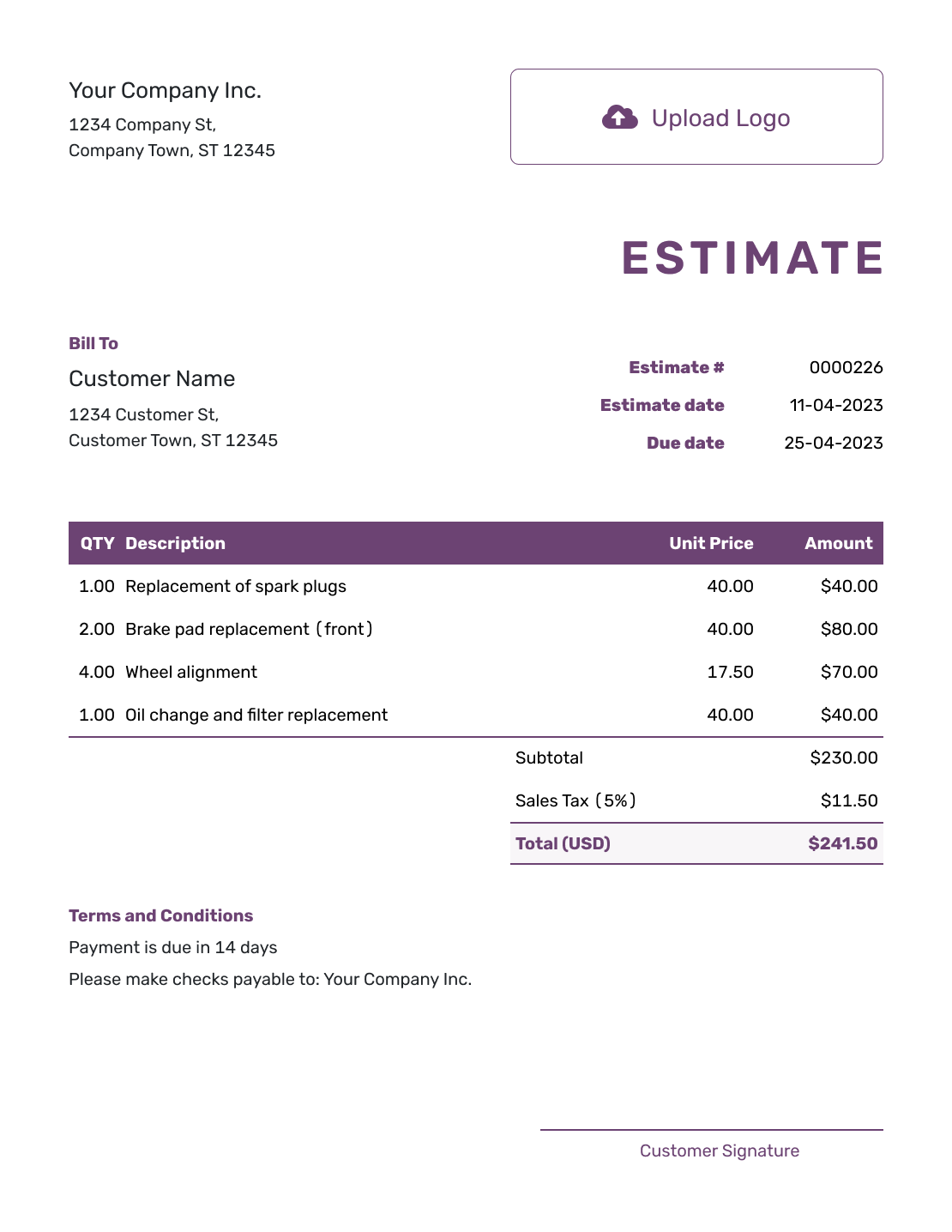
A simple estimate template contains only the basic parts of the estimate, with no extra bells and whistles. You should include your company name and your contact information, together with your customers name and their address. Also add an estimate number, date and due date. The line items are next: List the quantity, description, unit price and line amount for each item on the estimate.
Keep it simple but descriptive, so that there is no confusion about what you are proposing. Include taxes, discounts and an estimate total. Finally, add your terms and conditions. If you need to customize your estimate further, you can also add a signature field or a company logo.
The free estimate template includes all of these parts, and saves your precious time by doing the calculations for you.
Sample estimate template
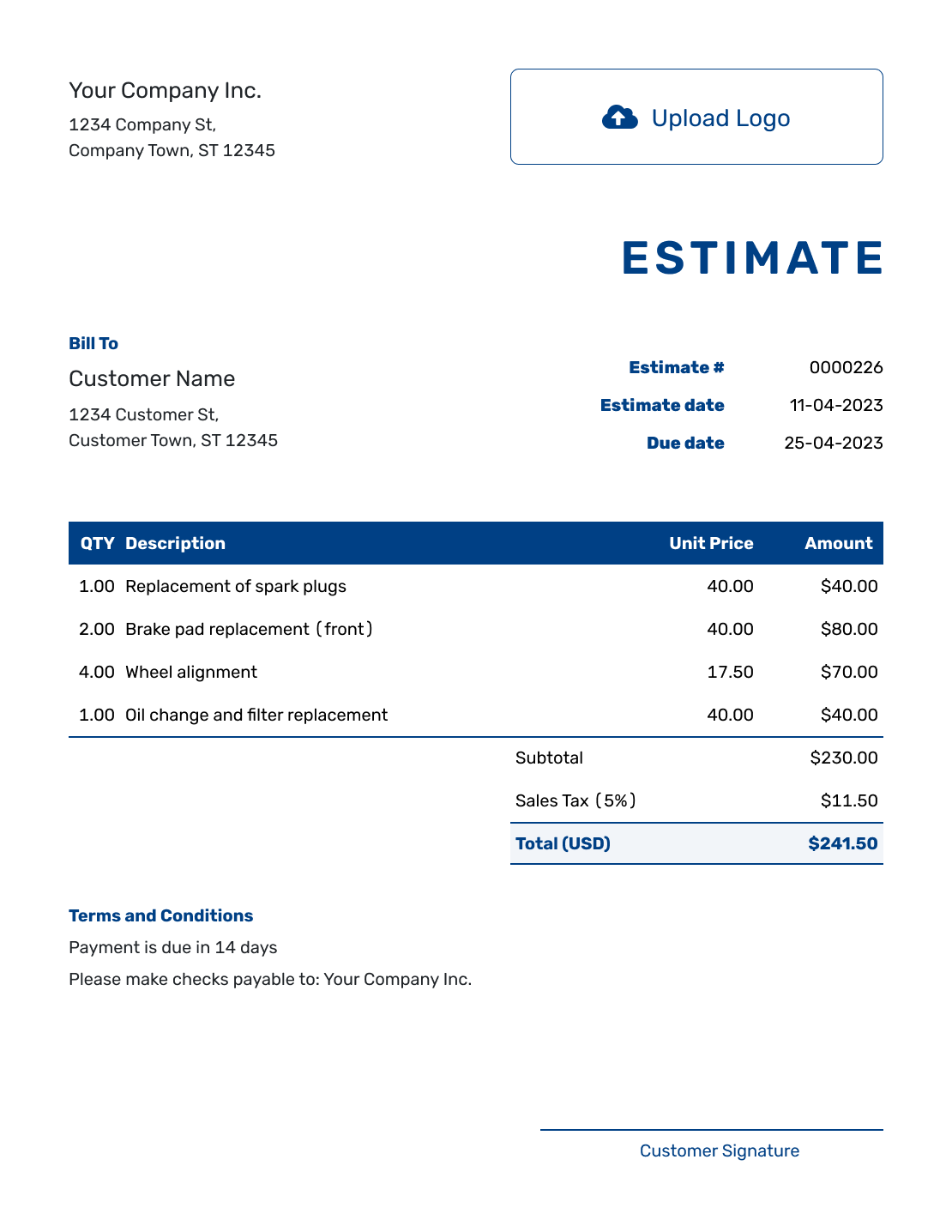
A sample estimate is just an example of how an estimate should look and what it should contain. It includes blank fields for you to fill out, reminding you to fill out all the relevant information in a structured format. The sample estimate template is designed in order to provide the best of the digital world for your business. It looks professional and can save you a lot of time. When you use the sample estimate provided by Docelf you will experience more control, traceability and well organized business documents. It is used by a range of service industries, like contractors, construction work companies, lawn care professionals, painters, roofers, auto repair businesses and more.
Job estimate template
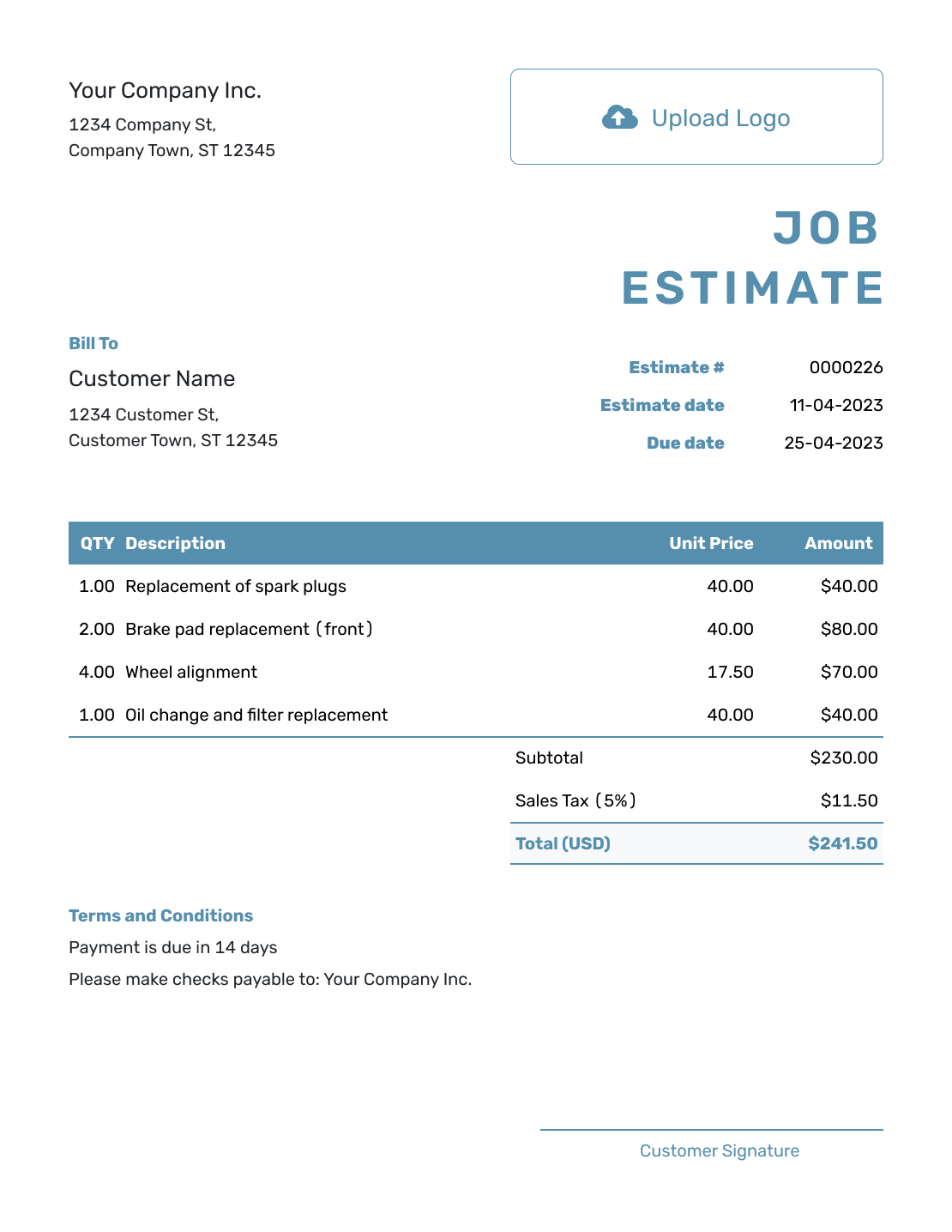
The purpose of writing a job estimate is to propose a project you want to do for your customer. Describe the job you are proposing by breaking it down into tasks. Describe each task and add your estimate of how much it will cost to do and how much time it will take. The customer can then make up their mind about whether or not to accept the proposed estimate and do business with you. The job estimate should make an educated guess about the price and the time it will take for the job to be completed. Estimates are usually used for larger jobs, where the scope of the job and the final cost are not fixed, and where there is some uncertainty about what they will be.
Work estimate template

A work estimate template contains an itemized list of all the work and costs that are proposed within the scope of a project. It is also common to include an estimate of the time it will take to complete the project. Rather than provide a fixed price or quotation, an estimate template is used to provide an educated guess about what the total project price will be. Work estimate templates are most common in larger projects where there is some uncertainty about either time to completion or the costs involved.
Estimate proposal template
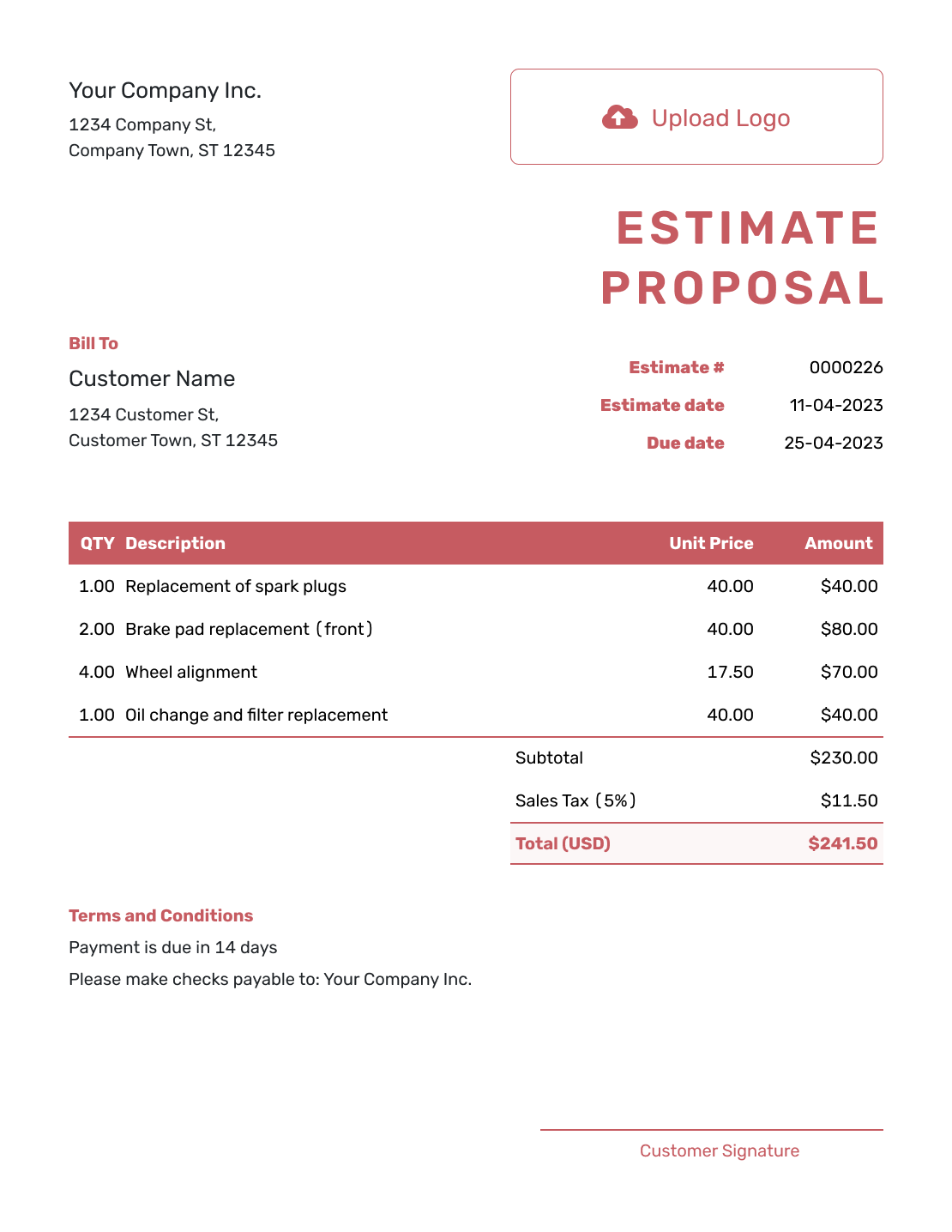
Just like the name indicates, an estimate proposal is a proposal sent to your customer to do business with you. Since there is some uncertainty about the scope of the project, the final price on the proposal is not fixed. It is a best guess of what the final price will be - a price estimate. With the free estimate template you can create professional estimate proposals to send to your customer.
Blank Estimate Template
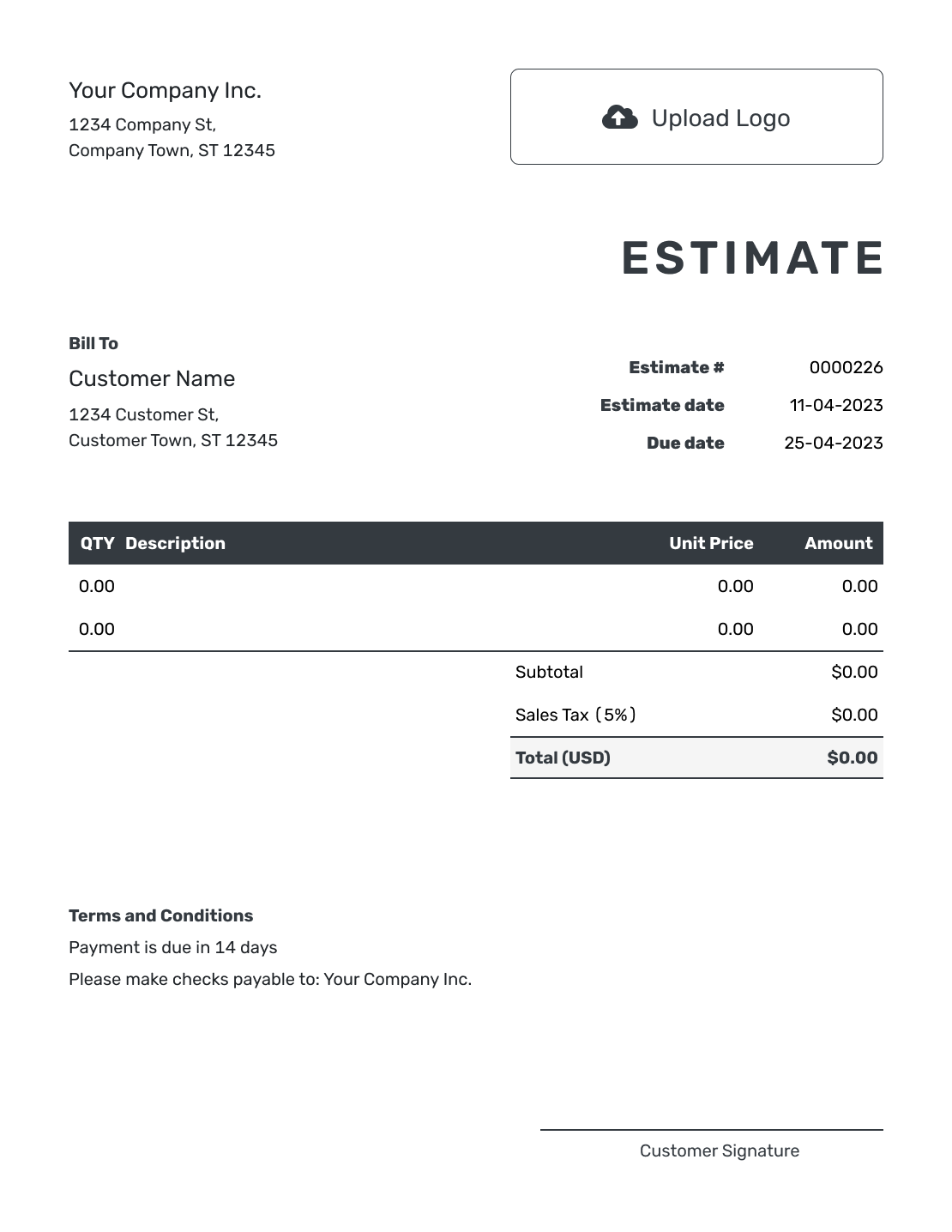
The blank estimate template is fillable, printable and downloadable. Just fill out the blank fields with your own estimate details. There is a blank field for your name and contact information and a blank field for the information of your customer. There are blank fields for the estimate number, date and due date. And there are blank fields for estimate line items. There is even a blank field for you to upload your company logo. With the blank estimate template you can write your estimate and send it in just a couple of minutes.
Frequently Asked Questions
What is an Estimate Template
An estimate template is a sales document. Estimates are used to propose a project where the price and the time to completion are uncertain. Instead, the estimate provides an educated guess about how much the project will cost to complete, how many work hours it will take and how much materials are needed.
The purpose of the estimate is to give the customer an idea of the final price for the work proposed. The actual cost might be more or less, depending on how the work progresses and which challenges turn up.
Use the sample estimate template provided above to create your own estimates.

Create a Free Estimate!
Create a professional estimate in seconds.
What is the Difference Between an Estimate and a Quote
As a document a quote looks very similar to an estimate. The only difference seems to be the name of the document. They both contain the same items and have the same outline. There is one crucial difference between quotes and estimates, however: A quote is a fixed price offer, while an estimate is a guess at the final cost of the project.
When you give your customer a quote, you are committing to stick to that price, even though the project ends up costing more. While it’s convenient for the customer to know exactly how much they’ll have to pay, it might be detrimental to your business in case unexpected problems turn up. You should reserve quotes for smaller projects, with little or no risk involved. Examples of industries that mostly use quotes are photographers and graphic designers. If you need to send a quote, use a quote template.
In contrast, an estimate proposal provides a best possible guess of what the final price and time to completion will be. Once the customer accepts the estimate and chooses to work with you, you are under no obligation to stick to those predictions. Needless to say, taking advantage of this to increase your price mid-way is a very bad idea. Unsatisfied customers are bad for business. Always try to make your cost and time predictions as accurate as possible and to communicate unexpected changes as soon as possible. That way, if problems turn up, you and your customer can work together towards a common solution.
What is the Difference Between an Estimate and an Invoice
An invoice and an estimate are documents that look quite similar but are used in the different parts of the sales process.
An invoice is a formal request for payment for services or goods provided. The invoice verifies that the exchange of goods and services between the buyer and the seller has taken place. It describes the transfer of products, goods or services from seller to buyer and makes a formal request for payment. It also establishes the legal obligation to pay on the part of the buyer. If you need to send an invoice use our invoice template.
An estimate is an offer to sell goods or services where the final price is not fixed. It is used to give the customer a price estimate when the scope of the project is uncertain. The estimate provides a best guess of how much a project will cost to complete and how much time it will take. There is no legal obligation to stick to those predictions.
Exceeding the cost or the timespan of a project without communication along the way is sure to earn you a very angry customer. Always try to keep your predictions realistic and to communicate any problems as soon as possible. That way, if problems arise, you and your customer have a chance of finding a solution that is agreeable to both.
What if the Final Costs Exceed the Estimate
An estimate does not constitute a binding agreement. It is just an educated guess of what the total cost and time spent on the project will be. If the final cost is more, the customer will have to pay more, and if the final cost is less, the customer will pay less.
That being said,you should probably not wait until the end of a project before telling the customer about the increased cost. It’s a sure way to earn an angry customer and bad reviews, and might even lead to legal disputes.
Instead, make sure that you communicate with your customer throughout the project. That way, if the price of the materials or the labor cost increases, you can inform your customer right away. You and your customer can then agree on whether the project should proceed as planned, or the scope of the project should be reduced in order to cut costs.
When it comes to cost increases, nobody likes surprises. Be sure to communicate potential cost increases as early as possible, and include your customer into the decision about how to handle the increase.
Why Use an Estimate Template
The advantage of providing an estimated cost, rather than a fixed price is that the risk associated with the project is carried by your customer, rather than your company. If unexpected costs arise it is the customer that will cover them. That said, you should always strive to provide your customer with the best cost estimate possible. You should also communicate what the uncertainties are and where potential cost increases might come from. That way, even if the price changes, it will not come as a total surprise to your customer.
If you need to provide your customer with a fixed price use a quote template instead.

Create a Free Estimate!
Create a professional estimate in seconds.
Who Needs an Estimate Template
If you run a business that provides services, an estimate template can save you time and make your work look professional. Whether you're in construction, home repair, auto repair, or even creative fields like graphic design or photography, giving your clients a clear price breakdown helps set expectations.
From contractors and painters to plumbers and electricians, an estimate template ensures your pricing is organized and easy to understand. Landscapers, tree trimmers, and cleaning services also benefit by showing clients upfront costs for their projects. Auto body shops, HVAC specialists, and roofers can use estimates to avoid misunderstandings about labor and materials.
Even businesses like catering, wedding planning, video production, and software development can use estimate templates to outline costs before starting a job. No matter your industry, a professional estimate builds trust with clients and helps you win more business. If your work involves a quote, an estimate template is a must-have!

Create a Free Estimate!
Create a professional estimate in seconds.
When Should I Use an Estimate Template
You should use an estimate template when the scope of the project you are proposing to your customer is unclear. That means that the cost of material, the labor cost, or the time to completion is uncertain. The estimate provides an educated guess based on best practice, so that your customer can have an idea of what the final cost of the project will be. The actual cost might be lower or higher. By providing an estimate you transfer the risk in the project to the customer. If the costs are larger than originally estimated, the customer will have to pay more.
If you prefer to work with fixed prices or work on projects without much risk, use a quote template instead.
What are the Benefits of Using an Online Estimate Template
- You look professional, because the template is designed to be clear, concise and to include all the necessary information.
- You save time, because your business information, company logo, payment terms and sales tax rates are already filled in.
- You won’t forget important parts of your estimates. The online template makes sure that all the formal information like estimate number, due date and payment information is included.
- You stay organized. The software automatically stores your customer information and related documents for future reference, and makes it easy to follow up on deadlines, payments and contacts.
- You can see when your customer has received, opened and accepted the estimate.
- After the work is completed and it’s time to invoice, you can convert your estimate directly to an invoice. No need to enter the same information twice.
- You can send your estimate directly, download it as a PDF and attach it to an email, or print it and mail to your customer.
What is Estimating Software
Cost estimation software is often used in large-scale projects in order to calculate the expected cost. It contains prices and estimated costs for labor, materials and products and uses these to estimate the final price of the project. An example of projects that benefit from use of estimation software are large construction projects, such as building a mall or an apartment complex.
For small businesses, estimation software is often too expensive and complicated to use. For a typical small contractor the cost and time spent learning the software will often outweigh the benefits. An estimate template conveys many of the same benefits, without the steep learning curve and the exuberant cost. Rely on your know-how about labor and material costs as well as the cost of similar projects in the past to make an educated guess about the final project cost. For larger projects, break the project into smaller parts and estimate the cost for each of them. A simple estimate template covers the estimating needs of most small business projects.
What Should I Include in an Estimate
Be sure to list all the contributing cost factors such as subcontractors, material costs, labor costs, permits and fees, etc. Don't forget to add sales tax and any discounts.
The customers are often very interested in the time it takes for a project to complete. Your estimates should therefore also include a line or two about the expected timeline and the total time to completion.
Finally, include the formal estimate parts like:
- Your company name and contact information
- Your branding (the company logo, slogan etc.)
- Your customers name and contact information
- Estimate issue date
- How long the estimate is valid (estimate due date)
- Information about expected deposits and payment plan
- Payment processing information
The Docelf estimate template includes fields for all of these items.
To make your estimates more accurate in the future you should always follow up and compare your estimated costs to the actual costs incurred during the project. That way you can adjust your estimates and make better cost and time predictions in the future.
How do I Turn my Estimate Proposal into a PDF Document
Creating a pdf from the estimate template is really simple: just click the ‘PDF’ button and your estimate proposal will download as a pdf file. You can then save it to a location of your choice, print it, or attach it in an email to your customer.
What are some Other Names for Estimate Template
The estimate template is sometimes called a proposal estimate template, a job estimate template or a work estimate template. It is also known as an estimate quote or an estimate proposal.
Common to all of these names is that they refer to a sales document that is used to propose a project when the price is not fixed. Estimates are usually used for larger projects where there is some uncertainty about the cost, the time the project will take, or both.
Other Estimate Template File Formats
The Docelf design team has created some beautiful sample templates in Word, Excel, Google Sheets and Google Docs. You can add your company logo and modify, print or send them as many times as you like. If you prefer to have more customization options and features, use the online estimate template instead.
- Word Estimate Template
- Google Docs Estimate Template
- Excel Estimate Template
- Google Sheets Estimate Template
Industry Specific Estimate Templates
For more estimating tips and templates tailored to a particular industry, check out our samples of industry specific estimate templates.
- Auto Body Repair Estimate Template
- Automotive Estimate Template
- Basement Renovation Estimate Template
- Bathroom Estimate Template
- Body Shop Estimate Template
- Body Work Estimate Template
- Builder Estimate Template
- Building Estimate Template
- Cabinet Estimate Template
- Car Repair Estimate Template
- Car Restoration Estimate Template
- Carpenter Estimate Template
- Carpet Cleaning Estimate Template
- Carpet Estimate Template
- Catering Estimate Template
- Cleaning Estimate Template
- Collision Repair Estimate Template
- Commercial Cleaning Estimate Template
- Concrete Estimate Template
- Construction Estimate Template
- Contractor Estimate Template
- Deck Estimate Template
- Demolition Estimate Template
- Dental Treatment Estimate Template
- Denture Treatment Estimate Template
- Design Estimate Template
- Drywall Estimate Template
- Electrical Estimate Template
- Electrician Estimate Template
- Excavation Estimate Template
- Exterior Painting Estimate Template
- Fence Estimate Template
- Flooring Estimate Template
- Framing Estimate Template
- Freelance Estimate Template
- General Contractor Estimate Template
- Graphic Design Estimate Template
- Gutter Estimate Template
- Handyman Estimate Template
- Hardscape Estimate Template
- Home Improvement Estimate Template
- Home Repair Estimate Template
- House Cleaning Estimate Template
- House Painting Estimate Template
- HVAC Estimate Template
- Independent Contractor Estimate Template
- Insurance Claim Estimate Template
- Interior Design Estimate Template
- Interior Painting Estimate Template
- Irrigation Estimate Template
- IT Project Estimate Template
- Junk Removal Estimate Template
- Labor Estimate Template
- Landscaping Estimate Template
- Lawn Care Estimate Template
- Lawn Mowing Estimate Template
- Lawn Service Estimate Template
- Masonry Estimate Template
- Mechanic Estimate Template
- Medical Estimate Template
- Mold Remediation Estimate Template
- Moving Estimate Template
- New Home Construction Estimate Template
- Painting Estimate Template
- Parking Lot Striping Estimate Template
- Paving Estimate Template
- Pest Control Estimate Template
- Photography Estimate Template
- Plumber Estimate Template
- Plumbing Estimate Template
- Pool Estimate Template
- Pressure Washing Estimate Template
- Project Estimate Template
- Remodel Estimate Template
- Renovation Estimate Template
- Repair Estimate Template
- Residential Cleaning Estimate Template
- Roof Repair Estimate Template
- Roof Replacement Estimate Template
- Roofing Estimate Template
- Service Estimate Template
- Siding Estimate Template
- Snow Removal Estimate Template
- Sod Estimate Template
- Software Development Estimate Template
- Tile Job Estimate Template
- Tree Removal Estimate Template
- Tree Service Estimate Template
- Tree Trimming Estimate Template
- Tree Estimate Template
- Vehicle Repair Estimate Template
- Veterinary Estimate Template
- Video Production Estimate Template
- Water Damage Estimate Template
- Web Design Estimate Template
- Website Estimate Template
- Wedding Estimate Template
- Window Cleaning Estimate Template
- Window Estimate Template
Additional estimate templates:
- Basic Estimate Template
- Bid Estimate Template
- Blank Estimate Template
- Business Estimate Template
- Cost Estimate Template
- Estimate Document Template
- Downloadable Estimate Template
- Estimate Email Template
- Estimate Example Template
- Estimate Form Template
- Estimate Format Template
- Estimate Invoice Template
- Estimate Letter Template
- Estimate Paper Template
- Estimate Proposal Template
- Estimate Quote Template
- Estimate Sheet Template
- Estimate Worksheet Template
- Formal Estimate Template
- Good Faith Estimate Template
- Itemized Estimate Template
- Job Estimate Template
- PDF Estimate Template
- Price Estimate Template
- Printable Estimate Template
- Professional Estimate Template
- Project Cost Estimate Template
- Quote Estimate Template
- Simple Estimate Template
- Work Estimate Template
Docelf Free Estimate Template

- PDF, Email or Print
- Convert to Invoice
- See when your estimate has been opened
- Get notified when your estimate is accepted
Other Docelf Templates
Our templates are designed to work together, so you don't have to enter the same information twice. When your customer accepts the quote or estimate you prepared for them, it easily converts into an invoice, which easily converts into a receipt. Maximum control with minimum effort!
All of Docelf templates offer the same styling options and simplicity of use as the invoice template.
Check out other templates from Docelf:


